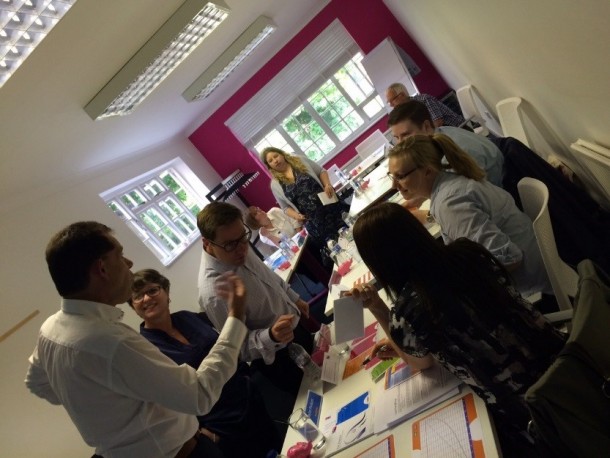Insights and takeaways from our roundtable event: Business & IT Alignment
A chance to network with peers, explore a recognised problem with subject matter experts and take away concrete improvement items. These were the results of the first exclusive round table event held by Pink Elephant in the UK.

Insights and takeaways from our roundtable event: Business & IT Alignment
Pink Elephant held an exclusive roundtable event on Friday 17th June 2016 around Business & IT Alignment. Business & IT Alignment has been a contentious ‘label’ for many years. However, 70% of IT departments are still unable to demonstrate value to their business. In order to address this, an interactive business simulation hosted by Paul Wilkinson (owner GamingWorks) was integrated within the event. The simulation involved both business & IT roles to help create a better understanding and a shared commitment for improving business & IT alignment capabilities.
Luci Allen, Head of Operation for Pink Elephant EMEA, opened proceedings with her vision about ITIL training based on her 20+ years’ of experience as a trainer and consultant:
“Yes you could just do the theory and try and pass the exam but we believe the real value comes from translating the theory into practice to solve recognised problems, which is why we use simulation games. Games are a great way to bring the stakeholders together, to create buy-in, practice applying the theory and capturing some real life CSI items to take away”
Paul Wilkinson then stepped in, already in character as CEO of the company Grab@Pizza challenging the audience “we’ve spent thousands on ITIL training, when are you going to deliver some real value?”
The Concept
Grab@Pizza is a very successful company selling millions of Pizza’s every year. But after 6 months in the current year, the sales figures are far below expectations. The CEO urged the Business Manager to make a challenging recovery plan. This plan is based on a 6 month strategy to bring the sales and profit back on target. IT is a crucial enabler for reaching new markets, streamlining processes and reducing administrative overheads. The IT department must organise themselves to explore the business demands, translate them to IT strategy and organise IT Support, IT Operations and Change Management to ensure that the business is successful at the end of the simulation.
Round 1
We played round 1, which resulted in total chaos. The gentleman playing the business relationship manager was so overwrought he just kept shovelling changes at the beleaguered Change Management team and no one was listening to either the Service Desk or the Problem Manager which let’s face it, never bodes well. The result? Grab@Pizza lost over $25 million in revenues due to failed changes and down time and everyone looked pretty stressed out. Paul as acting CEO was NOT happy.
Reflections – Round 1
After a quick coffee break, Paul encouraged everyone to reflect on round 1. As he explained it: “There’s not one organisation that does ITSM perfectly at the first attempt; ITIL by its very nature is built on CSI.”
Paul went on to explain the key pillars of the ITIL Practitioner course; Organisational Change Management, Measurement & Metrics & Communication, all underpinning a Continual Service Improvement ethos. Paul then encouraged us to use the ITIL Practitioner pillars to improve performance in round 2. The first thing to be discussed? A clear strategy and communication plan. It was agreed that the Business Relationship Manager would confirm the business strategy from the CEO and then work with IT to manage operational tasks accordingly. Next on the list was a CSI register, with everyone in the group contributing their ideas and action points.
 Paul went on to explain how using both ITIL and COBIT can get you better results because not only are you applying best practices, once you bring COBIT into the equation, you can look at business drivers and value realisation; in other words, you have an end to end value stream for your entire service. COBIT maps directly into ITIL with additional views on benefits, resources, risks and opportunities and provides a structured process-based approach for running services and mapping business objectives to IT goals.
Paul went on to explain how using both ITIL and COBIT can get you better results because not only are you applying best practices, once you bring COBIT into the equation, you can look at business drivers and value realisation; in other words, you have an end to end value stream for your entire service. COBIT maps directly into ITIL with additional views on benefits, resources, risks and opportunities and provides a structured process-based approach for running services and mapping business objectives to IT goals.
Fired up by coffee and Paul’s pep talk, it was time for round 2.
Round 2
Round 2 went much better! The first order of business was to confirm the strategy straight from the CEO via the Business Relationship Manager:
- Protect the environment during the Super Bowl month, because that’s when we make the most money:
- Make sure all RFCs are planned and scheduled via Change Management
- Convert $25 million loss to $6 million profit
- Have no down time in the working day
Having a defined strategy meant that Changes and projects could be planned in a reasonable manner rather than “who shouts the loudest” and the Service Desk were able to prioritise Incidents more effectively and pass recurrent tickets to problem Management. The result? One happy CEO and time to look at the learning points from round 2.
Learning Outcomes
Delegates experienced two rounds of the simulation game. In the first round the team experienced chaos, stress, confusion, they were disorganised, there was a lack of ‘flow’ through the process, there was significant loss of revenue caused by a business initiative failing and outages. Both IT related. The business was blaming IT and IT was blaming the business.
The ‘promised’ business project was not realised and not communicated (lack of transparency), whilst the business had notified the market of expected revenue growth – damaged business reputation and share value.
Change prioritisation was based upon ‘who shouts the loudest’ from the business and high impact outages were not recognised in terms of business loss or business damage.
The teams recognised that in their own organisations CSI is most commonly organised around specific teams or processes and not focused on the integration (collaboration) between processes, and not aligned end to end to realising value.
In the second game round the team had clear insights into the planned portfolio of investments and expected value creation. There was better insight into changes relating to VOCR and a business justification (Value creation vs preventing Value leakage) for all changes. The Service Desk was better able to plan and prioritise resources minimising downtime and the impact of downtime. Results? The least amount of loss caused by downtime in the previous 6 months, 25 million revenue growth….
At the end of the event we asked delegates. ‘What did you experience and apply in this simulation that you will now take away and apply in your organisation’?
“I am looking forward to introducing a lot of the useful tips we covered, I am sure they will help drive service improvements. In particular I will be doing some work on prioritisation of project resources, ensuring we have the right processes and people at our Change Advisory Board and also re-evaluating the BRM role. I look forward to attending any future events and will never again eat pizza without fully appreciating all the business processes which helped deliver it to my door.”
Fiona Hughes (Partnership ICT & Information Manager at Christenchurch and East Dorset Councils)
“Many thanks for this, it was a great day and something that I think we could benefit from within our organisation. It might help people get a better understanding of ITIL and the processes from doing it and having fun rather than in a training room.”
Chris Andrews (Service Management Consultant at London School of Economics)
